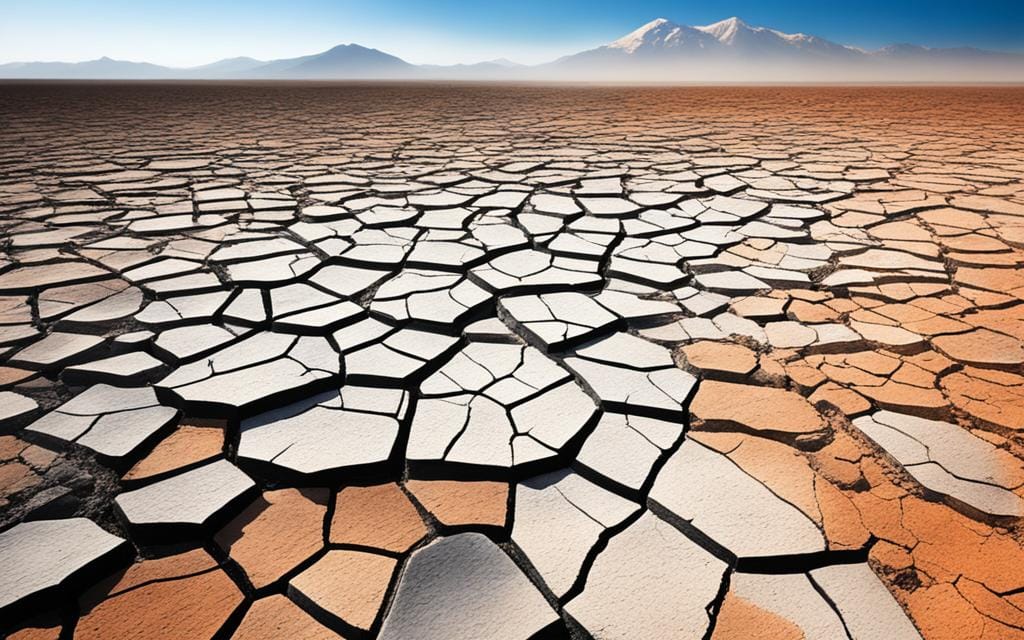Air pollution is huge in worsening the chemical weathering of rocks. It makes sulfur dioxide, nitrogen oxides, and particulate matter speed up the breakdown and erosion of the Earth’s surface rocks.
This article will look into how acid rain forms due to air pollutants. We will cover how oxidation processes play a role and how human activities and climate change increase the weathering rates. Moreover, we’ll talk about sustainable practices and mitigation strategies to deal with this problem.
Table of Contents
ToggleUnderstanding Chemical Weathering
Chemical weathering changes our planet’s surface over time. It breaks down rocks through reactions with the environment. This makes new, stable compounds. We will look into its main points like definitions, processes, and factors.
Definition and Processes
Chemical weathering transforms minerals in rocks by dissolution, hydrolysis, and oxidation. These changes happen when rocks meet water, acids, and air. This makes the rocks slowly break down. It turns them into important nutrients, new minerals, and wears down the Earth’s surface.
Factors Influencing Chemical Weathering
Many things affect how fast or strong chemical weathering is. Things like temperature, rainfall, acidity, and living things can make it happen more quickly. Warm weather and lots of rain speed up chemical reactions. Also, acid rain and organisms like plants, microorganisms, and animal life can speed up rock and mineral breakdown.
Learning about these basic chemical weathering processes, rock erosion, and mineral decomposition helps us understand how atmospheric conditions and biological processes change our planet’s surface.
Air Pollution: A Major Contributor
Air pollution comes from many human activities, putting out gases and particles. These include sulfur dioxide (SO2), nitrogen oxides (NOx), and stuff like dust and heavy metals. These pollutants, from industries and vehicles, mix with the air. This mix can create acid rain and make rocks break down faster.
Sources and Types of Air Pollutants
Factories and power plants are big sources of air pollution. So are cars, trucks, and farming. They add various pollutants to the air.
Impact on Atmospheric Composition
The mix of pollutants changes the air’s chemical makeup. This can cause acid rain, which breaks down rocks quicker. It can also speed up some natural processes, making things like weathering more intense.
Acid Rain and Rock Weathering
Acid rain is a major culprit in affecting the process of rock weathering. It forms when sulfur dioxide (SO2) and nitrogen oxides (NOx) mix with water and oxygen. Their marriage creates sulfuric acid (H2SO4) and nitric acid (HNO3). This rain makes the weathering of rocks like limestone, dolomite, granite, and basalt happen rapidly. It dissolves them or breaks them down through a chemical reaction.
Formation of Acid Rain
Sulfur dioxide and nitrogen oxides enter our atmosphere mostly through human activities. These include industries, power plants, and vehicles. When these chemicals meet water and oxygen in the air, they transform into strong acids. The result? Acid rain, which is much more acidic than normal rain.
Effects on Carbonate and Silicate Rocks
This acid rain affects not just the environment but also many types of rocks. It’s especially hard on limestone and dolomite because they break down easily in acid. They turn into carbonic acid, which dissolves them. This releases calcium and magnesium into the environment.
Granite and basalt face a similar fate. They too wear down quickly under acidic conditions. As a result, they release minerals and form new substances known as clay minerals.
How Does Air Pollution Impact Chemical Weathering?
Sulfur Dioxide and Nitrogen Oxides
Air pollutants like sulfur dioxide and nitrogen oxides play a big role in chemical weathering. Sulfur dioxide reacts with water to create sulfuric acid. This acid can dissolve and break down carbonate and silicate minerals. The breakdown of these rocks speeds up because of this process. Nitrogen oxides, on the other hand, can create nitric acid. This acid makes the environment even more acidic, boosting mineral breakdown.
Particulate Matter and Heavy Metals
Particulate matter and heavy metals that settle on rocks also affect chemical weathering. These substances speed up oxidation and mineral decomposition. This leads to more surface erosion and breaks down rock structures. This mix of air pollution effects increases the chemical weathering rate and intensity.
Oxidation Processes and Rock Weathering
Oxidation processes are very important in how rocks and minerals weather. Oxygen and ozone are big parts of these and they work on different materials, making them change slowly. But, things like air pollution can change how these processes work, by affecting the air’s oxidizing agents.
Role of Oxygen and Ozone
Oxygen is super important for making rocks and minerals break down. This is called oxidation. It makes these materials turn into different types that are more stable. Ozone is also in the mix, helping to speed up the wearing away of rocks.
Things like nitrogen oxides and tiny bits of matter in the air can throw off the oxygen and ozone balance. This can change how fast or strong the oxidation is. It leads to more wearing away of rocks and minerals. Knowing how these agents and air pollution mix helps us understand the effects on rock weathering.

Anthropogenic Factors and Environmental Degradation
Human activities, from industry to farming, play a huge role in air pollution. This pollution speeds up chemical weathering. This leads to the environmental damage we see today all over the world.
Industrial Emissions and Urban Air Pollution
Factories and power plants are big sources of pollution. They release gases like sulfur dioxide and nitrogen oxides. These mix with the air to form acid rain. This acid rain is harmful to rocks and minerals, wearing them down.
Cities are also packed with pollution sources, such as cars and construction. These add to the air’s harmful chemicals. This pollution worsens soil erosion and water quality.
Agricultural Practices and Biomass Burning
Agriculture adds its share of pollution. Fertilizers and pesticides send nitrogen compounds into the air. The burning of plants in farming and rural areas adds even more. This makes the air dirty with tiny particles and pollutants.
All these pollution types come together to quicken the wear and tear of our environment. They cause problems like soil erosion and water quality loss.
Climate Change Impacts on Weathering
The global climate is changing fast. We see its huge effect on how rock breaks down. The main things causing this are higher temperatures and different rainfall patterns.
Temperature and Precipitation Changes
When it gets warmer, rocks break down faster. This is because the heat speeds up certain chemical reactions. Also, rain patterns are changing. This can mean more heavy storms or longer dry spells. Both can affect rock weathering.
Sea Level Rise and Coastal Erosion
Climate change is making the sea levels rise. This leads to more coastal erosion. Stronger waves and tides cause rocks along the coast to weather more. This erosion harms buildings, roads, and nature, worsening climate change’s effects.
Rock Type and Vulnerability
The mineral makeup and structure decide how easily rocks weather chemically. Knowing which rocks are more likely to wear away is key. It helps us see how pollution affects nature.
Susceptibility of Different Rock Types
Carbonate rocks, like limestone and dolomite, dissolve easily in acid. This makes them sensitive to things like sulfuric and nitric acids from the air.
Silicate rocks, such as granite and basalt, break down more slowly. But, they can still weather through other processes. This is because of their different minerals, like feldspars and quartz.
Weathering Rates and Timescales
The speed at which rocks weather depends on the type. Carbonate rocks tend to dissolve faster. They can wear away in decades or over a few hundred years. Silicate rocks change more slowly, over hundreds to thousands of years.
Weathering is also influenced by the local climate and air quality. Stronger pollution can speed up the process. This leads to faster damage on both carbonate and silicate rocks.
| Rock Type | Weathering Susceptibility | Weathering Rates | Weathering Timescales |
|---|---|---|---|
| Carbonate Rocks (Limestone, Dolomite) | High | Rapid | Decades to Centuries |
| Silicate Rocks (Granite, Basalt) | Moderate to High | Moderate to Slow | Centuries to Millennia |
Case Studies and Real-World Examples
We’re going to look at how air pollution affects chemical weathering. We’ll check out studies from all over the globe. These stories will show how things like sulfur dioxide harm rocks in different places. This will help us understand air pollution’s role in breaking down Earth’s materials.
In Pittsburgh, Pennsylvania, a study shows how sulfur dioxide from industry damages stone buildings. This happens when the sulfur dioxide mixes with water to make sulfuric acid. It eats away at the stone, causing the structures to deteriorate quickly.
Italy’s coast also faces a similar issue with its marble statues. Vehicle fumes and the sea’s influence combine to create acid rain. This acid rain, with sea salt, damages the historic structures rapidly.
In Asia’s mountains, the story turns to biomass burning and farming. Particles and metals from these activities speed up the natural wear and tear of rocks. This process increases soil loss and harms the local ecosystem.
| Location | Air Pollutant(s) | Affected Rock Type | Observed Weathering Impacts |
|---|---|---|---|
| Pittsburgh, Pennsylvania | Sulfur dioxide | Limestone | Accelerated dissolution and degradation of building facades |
| Coastal regions of Italy | Particulate matter, nitrogen oxides | Marble | Rapid deterioration of historic statues and monuments |
| Asian mountain regions | Particulate matter, heavy metals | Granite, schist | Increased oxidation, hydrolysis, and soil erosion |
These studies highlight the serious effect of air pollution on rocks. They show us how pollutants speed up the damage to Earth’s surfaces. Understanding this can help us fight against these environmental issues.
Sustainable Practices and Mitigation Strategies
To tackle air pollution’s effect on chemical weathering, we need a wide approach. We should cut down on emissions from different areas like industries, transport, and farms. Achieving this will mean using better technology, changing policies, and making more rules.
Emissions Reduction and Air Quality Management
It’s key to lower harmful emissions to fight air pollution’s impact on weathering. We can do this by using clean energy, setting stricter rules for emissions, and pushing for energy savings. Also, by closely watching air quality and making sure everyone follows the rules, we can keep the air cleaner.
Conservation and Restoration Efforts
Not only must we cut emissions, but we also need to focus on saving and fixing our environment. This means planting more trees, saving natural areas, and fixing damaged ecosystems. Rebuilding these places helps the air, and it makes rocks and soil more resistant to damage from weathering.
A mix of greener living, less emissions, and caring for nature is our best bet. This way, we can fight the bad effect of air pollution on weathering. And we can protect our lands and resources for the long run.
Future Research and Monitoring
We must keep up the fight against air pollution’s effects on our world. Ongoing research will help us understand and solve this big environmental problem. Working together and sharing what we know will help us protect Earth’s ecosystems.
Advances in Atmospheric Modeling
Getting better at modeling the atmosphere is key. It helps us see how bad air can harm the Earth over time. With new technology and models, we can understand how air, climate, and damage to our world are linked. This knowledge will guide us to smart choices and actions.
Interdisciplinary Collaboration
Dealing with air pollution needs everyone’s skills, from scientists to policy makers. We need teamwork to find solid answers. Together, we can fight the main reasons for air problems, like industry and how we use land. A joint effort by many will help us make a world that takes good care of its resources and health.
FAQ
How does air pollution impact chemical weathering?
Air pollution worsens rock and mineral breakdown. Pollutants like sulfur dioxide and nitrogen oxides speed up this process. They cause acid rain and oxidation, which eat away at Earth’s surface.
What are the sources and types of air pollutants that contribute to chemical weathering?
Air pollution comes from factories, cars, and farming. These things put out sulfur dioxide, nitrogen oxides, and more. They change the air’s chemistry and speed up how rocks wear down.
How does acid rain formation contribute to chemical weathering?
Acid rain is made by pollutants reacting with water and oxygen. It makes strong acids. These acids eat away quickly at rocks like limestone and granite. They dissolve minerals and break down rocks.
What is the role of oxidation processes in air pollution-driven chemical weathering?
Oxidation is key in breaking down rocks. Air pollution affects these processes too. Certain pollutants change the air’s chemicals. This makes rocks wear down faster.
How do anthropogenic factors and environmental degradation contribute to chemical weathering?
People’s daily actions, industry, and farming cause pollution. This pollution speeds up how rocks and minerals weather. It leads to more environmental damage.
How does climate change impact chemical weathering rates?
Climate change can make rocks weather faster. Higher temperatures and altered rains change how rocks break down. Rising sea levels can also wear away rocks on coasts faster.
How do different rock types vary in their vulnerability to air pollution-driven chemical weathering?
The type of rock affects how easily it weathers. Rocks like limestone dissolve quickly in acid. Others, like granite, resist but still break down. It’s all about their mineral makeup.
What sustainable practices and mitigation strategies can address the impacts of air pollution on chemical weathering?
To lessen air pollution’s effect on rocks, we need many solutions. We must cut down on pollution from industries, cars, and farms. Protecting natural areas and planting trees can also help against air pollution.
What are the future research and monitoring needs related to air pollution’s impact on chemical weathering?
We need to keep studying air pollution’s effect on rocks and soils. Better models can predict what might happen. Teamwork between scientists and leaders is crucial. It will help plan how to protect our environment for the long run.









